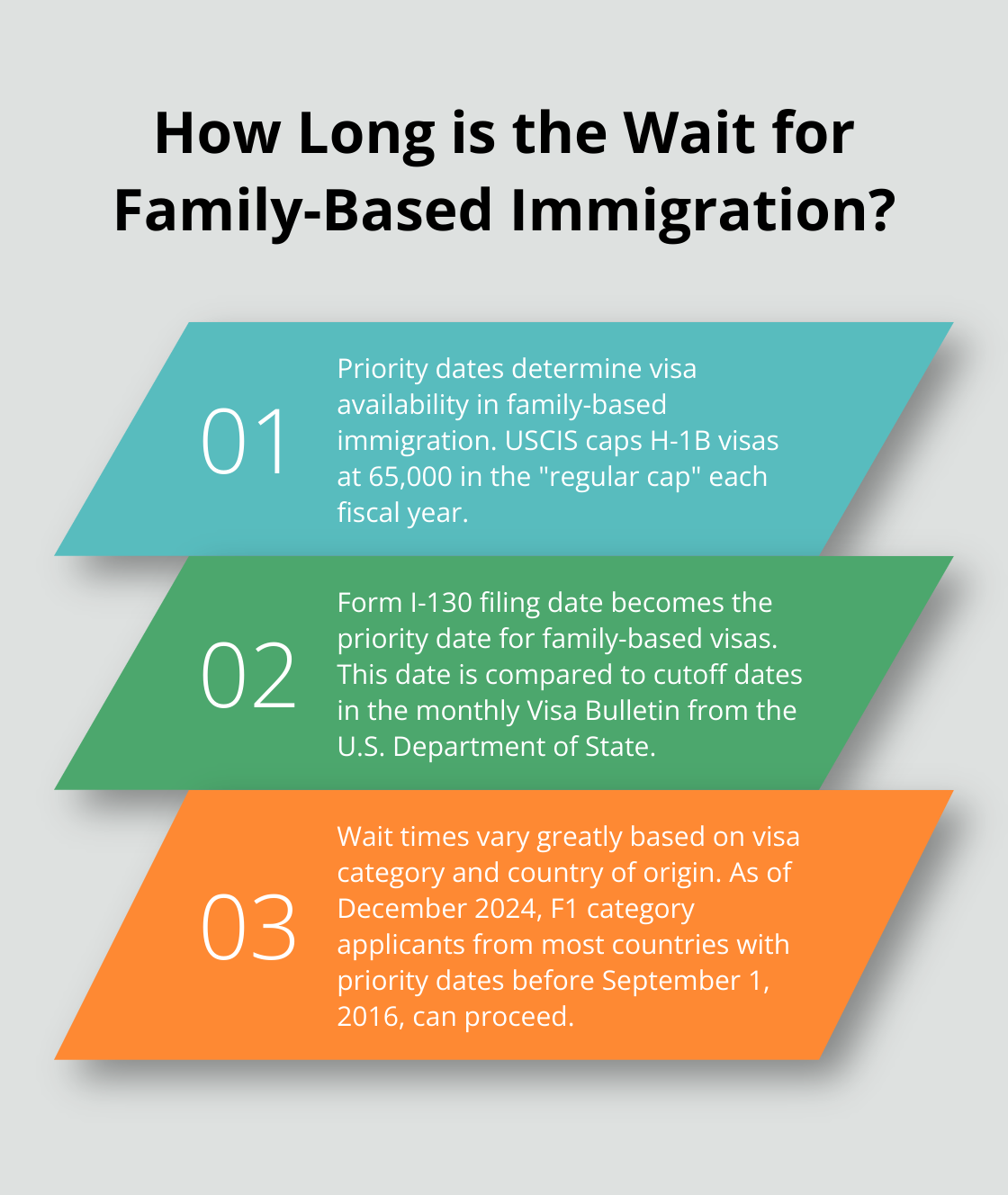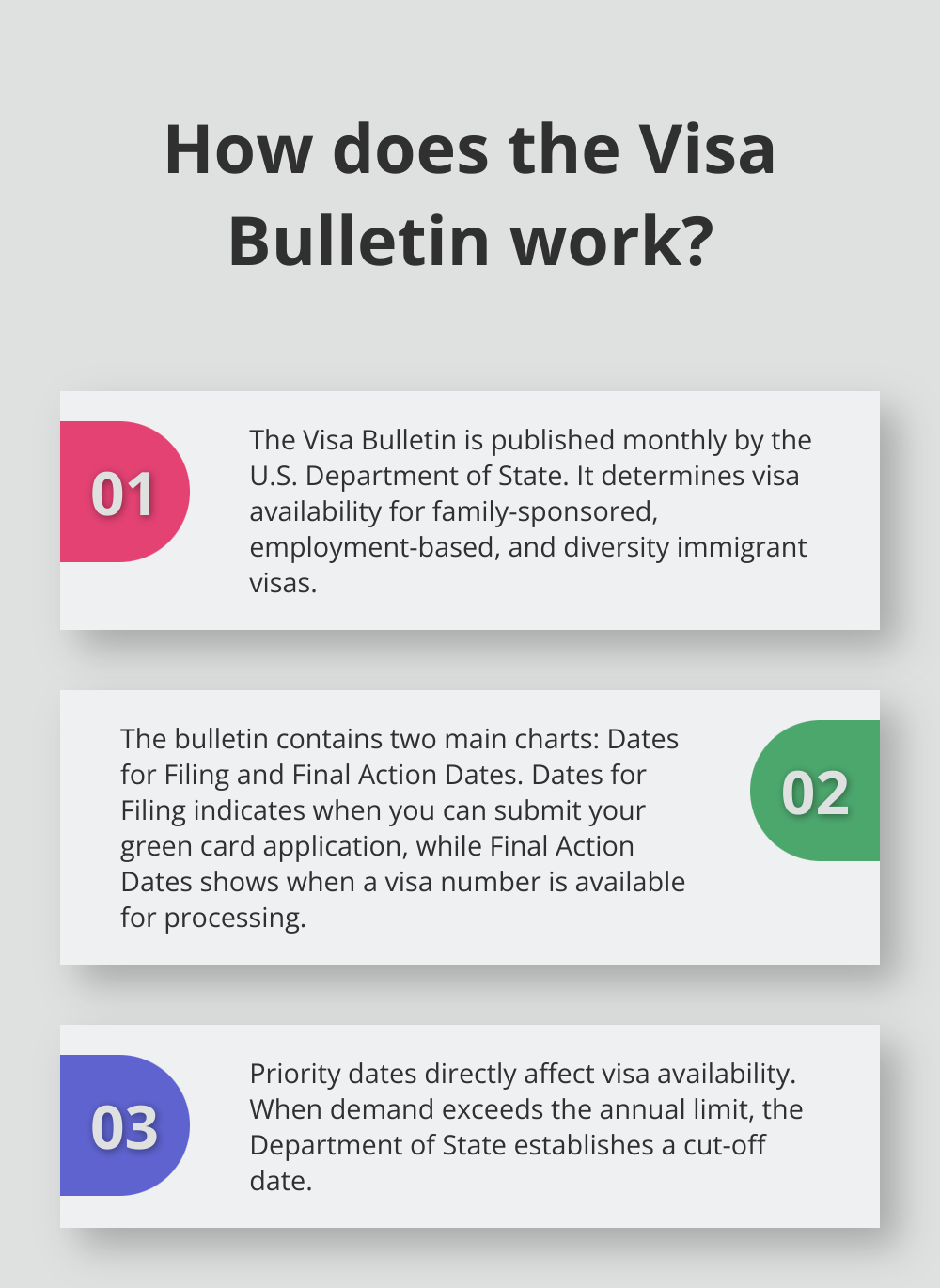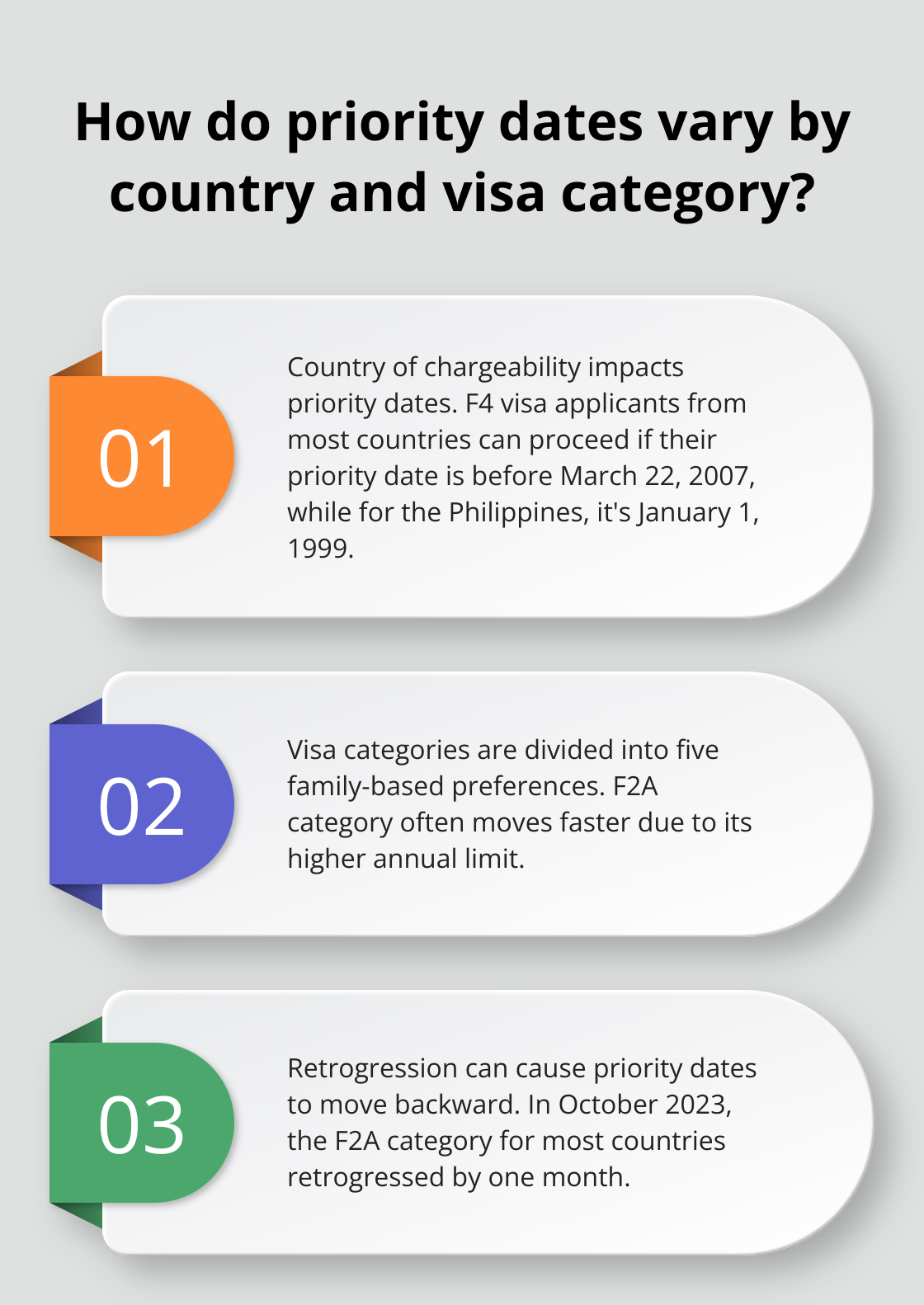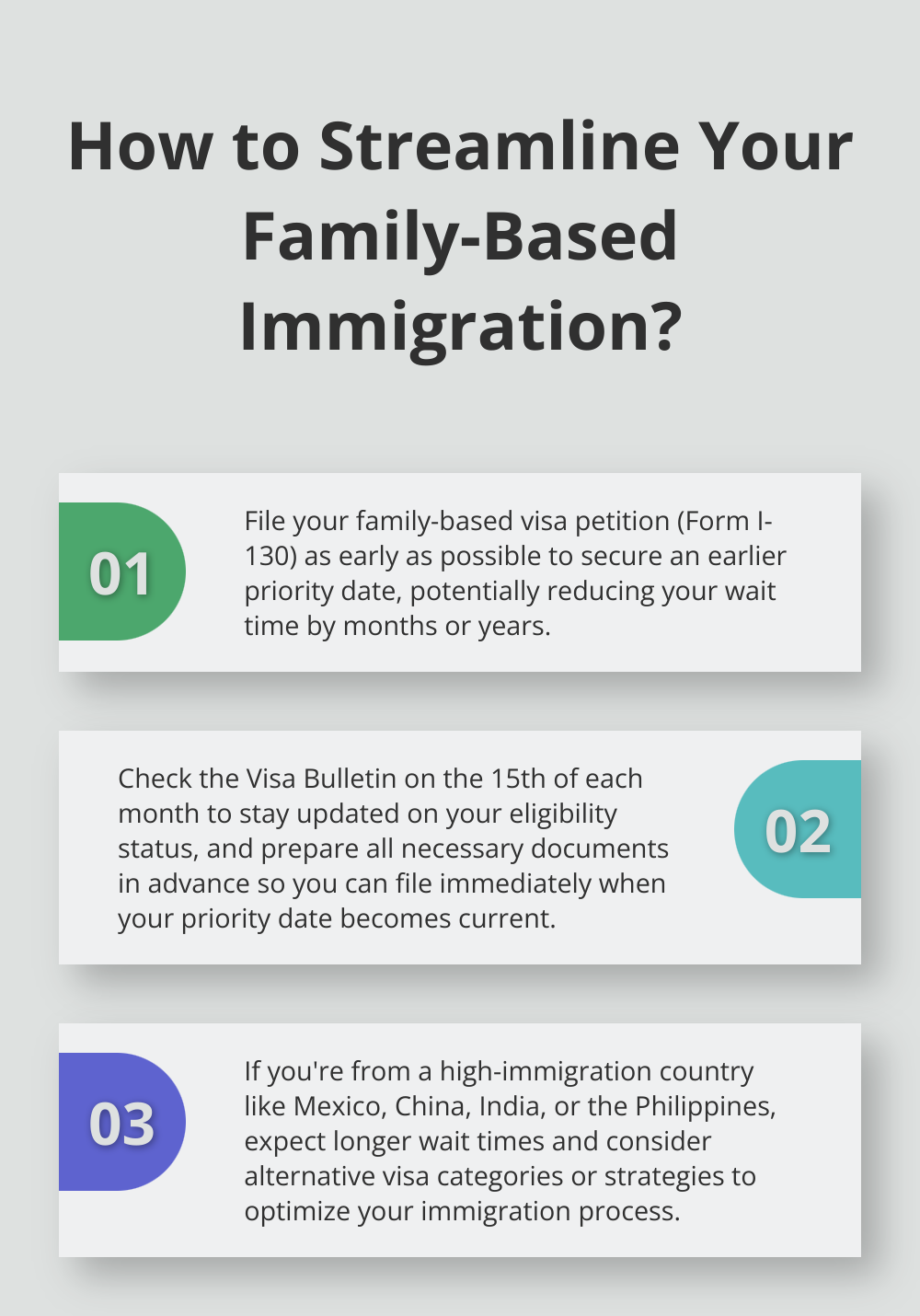
Family Immigration: Understanding Priority Dates
Family immigration priority dates play a crucial role in the U.S. immigration process. These dates determine when individuals can apply for their green cards based on family sponsorship.
At Law Offices of Jeffrey A. Thompson, we understand the complexities of navigating the family-based immigration system. This blog post will break down the concept of priority dates, explain their significance, and provide insights into how they affect your immigration journey.
What Are Priority Dates?
Definition and Importance
Priority dates form the backbone of family-based immigration. These dates represent when the U.S. Citizenship and Immigration Services (USCIS) receives a properly filed visa petition. They act as a placeholder in the immigration queue, determining when an immigrant visa becomes available for a family member.

The significance of priority dates cannot be overstated. They determine when an individual can progress to the next step in their immigration journey. The U.S. government caps the number of H-1B visas at 65,000 in the “regular cap” each fiscal year. This limitation creates a waiting period for many applicants, making priority dates essential for queue management.
How Priority Dates Function
When a U.S. citizen or lawful permanent resident files a family-based visa petition (Form I-130), the date USCIS receives this petition becomes the priority date. This date is then compared to the cutoff dates listed in the monthly Visa Bulletin published by the U.S. Department of State.
Impact on Immigration Timeline
Your priority date directly affects your visa wait time. For instance, if you’re the unmarried adult child of a U.S. citizen (F1 category), your wait time can vary significantly based on your country of origin. As of December 2024, applicants from most countries with priority dates before September 1, 2016, can proceed with their applications. However, those from Mexico face a longer wait, with only those having priority dates before April 1, 2001, being eligible.
Strategies for Optimal Priority Dates
To secure an earlier priority date (potentially reducing wait time by months or even years), it’s advisable to file petitions as early as possible. This strategy can significantly impact your immigration timeline.
The Role of Legal Assistance
Navigating the complexities of priority dates and family-based immigration can be challenging. Professional legal assistance can provide valuable insights and guidance throughout this process. At the Law Offices of Jeffrey A. Thompson, we offer expert guidance in immigration matters, helping clients understand and navigate the intricacies of priority dates and visa applications.
As we move forward, let’s examine the Visa Bulletin and its critical role in the immigration process, which directly relates to these priority dates.
How the Visa Bulletin Works
Understanding the Visa Bulletin
The Visa Bulletin, a monthly publication by the U.S. Department of State, determines visa availability for family-sponsored, employment-based, and diversity immigrant visas. This tool is essential for understanding when you can proceed with your green card application.
Interpreting the Charts
The Visa Bulletin contains two main charts: the Dates for Filing and the Final Action Dates.
- Dates for Filing: This chart indicates when you can submit your green card application.
- Final Action Dates: This chart shows when a visa number is actually available for your application to be processed.

To use the Visa Bulletin effectively, locate your visa category and country of chargeability. If your priority date precedes the date listed in the appropriate chart, you’re eligible to move forward with your application.
Example of Visa Bulletin Use
As of December 2024, if you’re in the F2B category (unmarried sons and daughters of permanent residents) from India, and your priority date is before June 1, 2017, you can file your application according to the Dates for Filing chart.
Visa Availability and Priority Dates
Priority dates directly affect visa availability. When demand exceeds the annual limit for a particular category or country, the Department of State establishes a cut-off date. This creates a waiting line, with only those having priority dates before the cut-off being eligible to apply.
It’s important to note that visa availability can change monthly. Sometimes, dates move forward, allowing more people to apply. Other times, they can retrogress, pushing back eligibility for some applicants.
Strategies for Effective Navigation
To maximize your chances of a smooth immigration process, consider these strategies:
- File your petition as early as possible to secure an earlier priority date.
- Check the Visa Bulletin regularly (it’s updated on the 15th of each month).
- Prepare your documents in advance, so you’re ready to file as soon as your priority date becomes current.
Understanding the Visa Bulletin is just one part of the complex immigration process. The next chapter will explore the various factors that can affect priority dates, including country of chargeability, visa category, and the phenomenon of retrogression.
What Influences Priority Dates?
Country of Chargeability
Your country of chargeability (typically your country of birth) significantly impacts your priority date. The U.S. government imposes per-country limits on the number of immigrant visas issued annually. This results in longer wait times for applicants from countries with high immigration rates to the U.S. (such as Mexico, China, India, and the Philippines).

As of December 2024, F4 visa applicants (siblings of U.S. citizens) from most countries can proceed if their priority date is before March 22, 2007. However, for applicants from the Philippines, only those with priority dates before January 1, 1999, are eligible. This stark difference highlights the impact of country-specific backlogs.
Visa Category and Preference
The visa category you fall under significantly affects your priority date movement. Family-based preferences are divided into four categories:
- F1: Unmarried sons and daughters of U.S. citizens
- F2A: Spouses and children of permanent residents
- F2B: Unmarried sons and daughters (21 and older) of permanent residents
- F3: Married sons and daughters of U.S. citizens
- F4: Brothers and sisters of adult U.S. citizens
Each category has its own annual numerical limit, which directly impacts how quickly priority dates move. The F2A category often moves faster than others due to its higher annual limit.
Retrogression and Its Effects
Retrogression occurs when the priority date for a particular visa category moves backward instead of forward. This happens when more people apply for a visa in a specific category than there are visas available.
For instance, in October 2023, the F2A category for most countries moved from September 1, 2022, to August 1, 2022 (a retrogression of one month). This meant that some applicants who were previously eligible to file their applications suddenly found themselves ineligible.
Retrogression can frustrate applicants who were close to filing their applications. It’s important to prepare for this possibility and to have a strategy in place. Try to gather all necessary documents well in advance, so you’re ready to file as soon as your priority date becomes current.
Impact of Legislative Changes
Legislative changes can also influence priority dates. New immigration laws or amendments to existing ones can alter visa availability and processing times. These changes may result in sudden shifts in priority dates, affecting applicants across various categories.
Annual Visa Allocation
The annual allocation of visas for each category and country can cause fluctuations in priority dates. At the start of each fiscal year (October 1), new visa numbers become available. This often results in significant forward movement of priority dates, especially for oversubscribed categories or countries.
Final Thoughts
Family immigration priority dates determine when individuals can progress in their journey toward permanent residency. The monthly Visa Bulletin provides essential information on current priority dates for various visa categories and countries of chargeability. Factors such as country of origin, visa category, and annual visa allocation influence how quickly priority dates advance.

We recommend that you check the Visa Bulletin regularly, prepare necessary documents in advance, and understand how legislative changes might impact your case. These steps will help you manage your immigration journey effectively. Staying informed about priority date movements is essential for successful immigration planning.
At Law Offices of Jeffrey A. Thompson, we guide clients through the complexities of family-based immigration. Our expertise allows us to provide tailored advice and support throughout the entire process. From filing initial petitions to navigating priority date changes, we strive to help you achieve your immigration goals.


